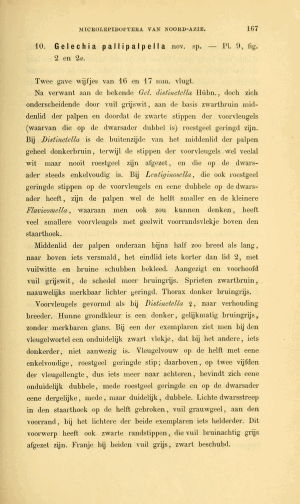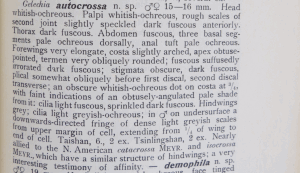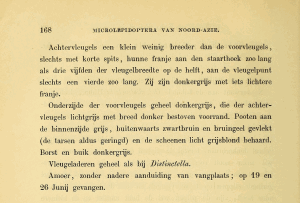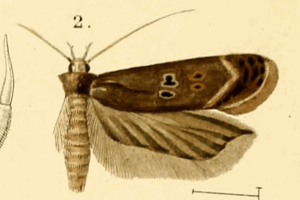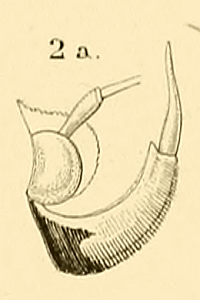2. Diagnose
2.1. Erstbeschreibung
2.2. Beschreibung als Gelechia autocrossa
4. Weitere Informationen
4.1. Andere Kombinationen
- Gelechia pallipalpella Snellen, 1884 [Originalkombination]
4.2. Synonyme
- Gelechia autocrossa Meyrick, 1937 [synonymisiert durch Bidzilya & Nupponen (2018)]
- Filatima autocrossa (Meyrick, 1937)
4.3. Taxonomie
Das Taxon wurde in Europa bisher teilweise unter dem Namen Filatima autocrossa (Meyrick, 1937) geführt. Bidzilya & Nupponen (2018) synonymisieren es mit der aus der Amur-Region beschriebenen Filatima pallipalpella (Snellen, 1884). Sie begründen: "Gelechia pallipalpella was described based on two females collected in the Amur region of Russia. Gelechia autocrossa was described on the basis of four specimens of both sexes from eastern China: Taishan, Shandong Province (see for details Junnilainen et al. 2010). The adult and the genitalia of both sexes were re-described based on material from the southern Ural Mountains (Junnilainen et al. 2010). We examined additional females of F. autocrossa from Buryatia and southern Urals and compared them with a photograph of the lectotype (adult) and its genitalia (both a photograph and a drawing of the slide (Sattler 1968)) of F. pallipalpella. The females were very similar both externally (Figs 55–59) and in genitalia, having a very characteristic sub-rectangular antrum and ribbon of minute cornuti near the accessory of the ductus bursae (Figs 60, 61, 61a). Unfortunately the segment VII of the lectotype of the female genitalia of G. pallipalpella is not on focus on the photograph, so that it is unclear if it has microsculpture on sub-ostial lobes. However, the Sattler’s drawing shows that microsculpture is present in the lectotype, but not as extensive as in specimens from southern Ural Mountains. Our study shows that this character along with the shape and dentation of the signum lobes are rather variable within Filatima. Hence, we consider the two taxa conspecific and establish here the following synonymy: F. autocrossa (Meyrick, 1937) syn. nov. of F. pallipalpella (Snellen, 1884).
4.4. Faunistik
Die Art ist aus Europa nur von der unteren Wolga-Region und dem Süd-Ural (dort als F. autocrossa gemeldet) bekannt. Bidzilya & Nupponen (2018) schreiben zur Gesamtverbreitung: "Russia: Lower Volga, southern Ural, Novosibirsk region (new record), Altai, Tuva, South of Krasnoyarskiy krai, Buryatia (new record), Zabaikalskiy krai, Amur region, Primorskiy krai (Junnilainen et al. 2010; Ponomarenko 2008, 2016); China: Shandong Province."
(Autor: Erwin Rennwald)
4.5. Literatur
- Bidzilya, O. & P. Huemer (2022): New species and new records of the genus Filatima Busck, 1939 (Lepidoptera, Gelechiidae) from Central Asia. — ZooKeys 1099: 87-110. [Zum PDF auf zookeys.pensoft.net]
- Bidzilya, O. & K. Nupponen (2018): New species and new records of gelechiid moths (Lepidoptera, Gelechiidae) from southern Siberia. — Zootaxa 4444 (4): 381–408. [https://doi.org/10.11646/zootaxa.4444.4.2]
- Beschreibung als Gelechia autocrossa: Meyrick, E. (1937): List of Microlepidoptera of Taishan. — Deutsche Entomologische Zeitschrift „Iris“ 50 (4): 154-159. Dresden.
- Erstbeschreibung: Snellen, P. C. T. (1884): Nieuwe of weinig bekende Microlepidoptera van Noord-Azie. Tweede gedeelte: Tineina en Pterophorina. — Tijdschrift voor Entomologie 27: 151-196 + pl. 8-10.




![Vorkommen in Russland (europäischer Teil bis Manytsch-Niederung) [Sinev (2021)]](/res/img/flag/ru.gif)
![Vorkommen in Kirgisistan [Bidzilya & Huemer (2022: 106)]](/res/img/flag/kg.gif)

